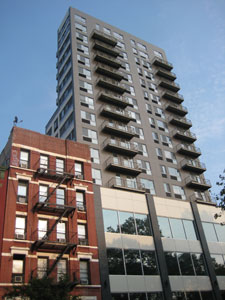Trending
Delancey rising
New tower 38 Delancey is marketing its unsold units as luxe rentals

38 DelanceyA huge condo touting its cool credentials and top-of-the-line finishes (recessed ceiling lights!) may seem about as au courant as having a Friendster account.
But that’s exactly what’s happening on the Lower East Side, where 38 Delancey, a 17-story, gunmetal-gray high-rise developed by the Yang Tze River Realty Corporation at Forsyth Street, is opening.
In true mid-2000s fashion, the building, which is poised to start closing its 56 apartments this month, touts a downtown address “where history meets hip,” according to its website.
Yet with new worries of a double dip in housing, a cold dose of 21st-century reality may be intruding at the building, which has 42 units in contract.
Indeed, last month, Yang Tze River Realty, which is run by Lee Yam, a kitchen supply businessman who’s constructing his first residential building, decided to put a batch of unsold units on the market as rentals, according to sources close to the project.
Repeated requests to representatives of Yam for comments about the project were unsuccessful. Meanwhile, brokers on the sales team, which is run by two firms, the Corcoran Group and Prudential Douglas Elliman, said they could not comment about 38 Delancey without permission from Yam first.
However, Larry Michaels, a Prudential Douglas Elliman broker who sells in the neighborhood, said renting unsold units in general is a symptom of a still-weak sales environment.
“This is a play you do when you’ve missed the market, or the market is not where you want to be,” said Michaels, who is currently marketing 50 Orchard Street, a nearby new luxury condo that’s sold 18 of its 25 units in four years.
Nevertheless, Michaels said that 38 Delancey’s move to rentals is a shrewd one. Those 42 sold units have likely generated enough cash for Yam to pay back his lender, so now he can hang on to the rest, wait for the market to bounce back and then sell them down the road for higher prices, Michaels explained.
Plus, according to Michaels, a high enough percentage of the building is sold to satisfy the current requirements of most lenders. In other words, existing buyers shouldn’t encounter snags this month when attempting to close.
While sales may currently be soft at 38 Delancey, the building appeared to be selling well before Yam changed course. From May, when the sales office opened, until mid-August, 38 Delancey recorded 42 units in contract, StreetEasy shows.
Listing prices were between $900 and $1,300 a square foot, while closing prices are not yet available. Buyers will be greeted by nine-foot ceilings, red-oak floors and shiny metal countertops, which were inspired by tables sold through Yam’s supply business, sources say. The views from the units, most of which have private balconies, sweep from the Financial District to the Empire State Building.
The building also contains three floors of retail space totaling 15,000 square feet, none of which has yet been leased. Michael Chen, the broker who’s marketing the retail units, claims they are “the prime space on the Lower East Side.”
Like the nearby Blue Condominium, or the Thompson LES hotel, which the monochromatic, metal-paneled 38 Delancey somewhat resembles stylistically, the tower capitalizes on its lofty height in an area dominated by low-slung brick tenements to offer panoramas.
But those views also have a sort of retro feel to them. In 2008, as part of a 110-block rezoning, the city made it tougher for buildings on the Lower East Side to grow large unless they provide affordable housing, which 38 Delancey does not.
While 38 Delancey was exempt from the rezoning, as it broke ground in 2007, it and other towering structures have prompted some community leaders to take action against future development of this type in next-door Chinatown, which was exempted in the 2008 rezoning.
The Coalition to Protect Chinatown and the Lower East Side, an advocacy group, is now pushing to create a special low-scale zoning district in Chinatown.
“Of course we don’t agree with that kind of development,” said Josephine Lee, a group coordinator. Besides its out-of-context aesthetics, luxury housing like this, she added, “is going to raise rents in our community.”




